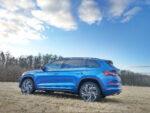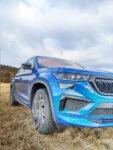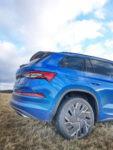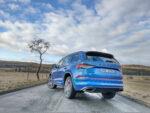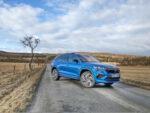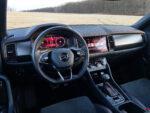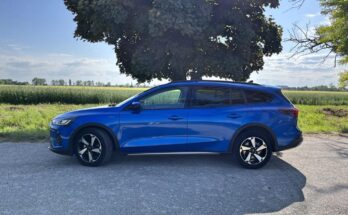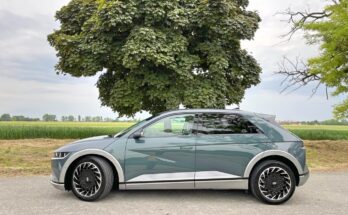The largest SUV from Mladá Boleslav treated itself to a traditional rejuvenation treatment. The modernized Skoda Kodiaq version of Laurin & Klement passed our editorial test at the end of last year. Now, however, we have the top version of the RS, which, in addition to its optical innovations, also packs a new drive unit. The flagship Kodiaq RS is no longer powered by a "powerful" twin-turbocharged diesel, but by the gasoline 2.0 TSI that we know from the "heresy" Octavia.
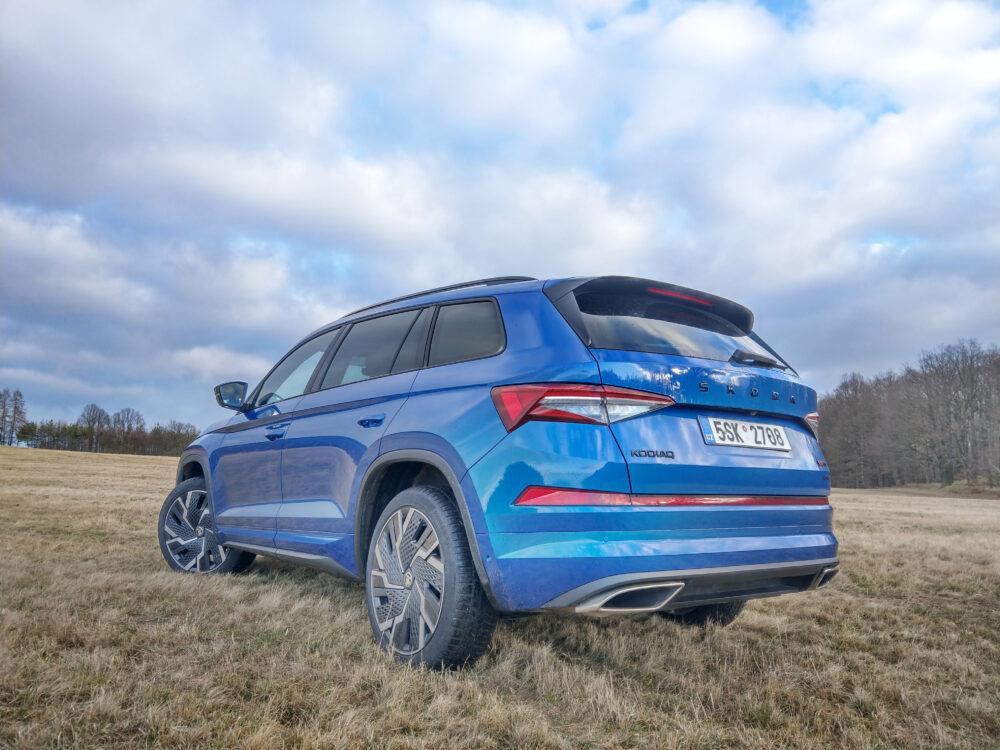
Exterior
The modernization of the Kodiaq has played with the exterior appearance of the car only minimally, but quite clearly. The basic contours of the car remain traditionally preserved and only individual details change on the car.
The front part underwent the biggest change, which now has new-shaped headlights. The headlights are newly equipped with the LED Matrix function and their shape strictly follows the front fascia. The front mask received a new treatment with a more pronounced shaping of the individual slats. The front hood has also received similar modifications, and clearly visible changes have also taken place in the front bumper, the tested version of the RS will also offer its more aggressive shaping and differently distributed paintwork of the lower part.
The rear part has a slightly changed shape of the rear lamps, a new spoiler for the fifth door and also a pair of bulky chrome exhaust tips, which are no cheap imitations. Naturally, the RS version has a continuous "reflector" across the entire rear bumper.
The traditional side profile of the Kodiaq is greatly enlivened by 20″ wheels, which, however, are newly equipped with plastic covers that reduce emissions and the car's consumption. The main advantage of these covers is that they are fully removable and can easily form a year-round display on the puppy of your garage.
The current modernization has brought Kodiaq more robustness, and the sides of the expression itself seem significantly more aggressive. For the tested sports version of the RS, this shift is quite beneficial, but I am not entirely sure about it for the classic, more popular versions.

Interior
The current rejuvenation of the car affected its interior only marginally. It continues to be dominated by a relatively subtle horizontally divided dashboard with a pair of pleasantly sized displays. The top RS will then offer a fully digital instrument panel with a diagonal of 10.25″. The data displayed here will offer traditional, red-toned graphics and multiple display modes. The on-board infotainment display has the Columbus system and a 9.2" diagonal. The layout of the dashboard is still very clear, ergonomically well managed and the controls are mainly represented by classic controls. Which is very positive information.
The sporty character of the RS version is manifested in the interior quite traditionally. There are therefore sport-cut seats with integrated headrests, or the ubiquitous stitching with red thread. New in the Kodiaq is the multifunctional steering wheel, which we know from other newer models of the brand. In the case of the RS version, it is three-armed and equipped with an RS plaque. We can also find this on the quite massive selector of the automatic transmission, which forms a certain dominant feature of the central tunnel .
In terms of interior space, the Kodiaq is still just as good after the modernization. The tested piece also offered an additional seven-seat specification in the form of a folding third row of seats. The access and seating space itself is of course adequate for the size of the luggage compartment. Traveling here is therefore more of an emergency, or intended for the smallest members of the family.
The installation of a gasoline engine enabled the presence of the battery, traditionally in the engine compartment. This results in a positive increase in the volume of the luggage compartment to the basic 835 l volume and the presence of a classic coasting wheel.

New gasoline motorization and driving impressions
The biggest change of the current modernization affected the tested Kodiaq RS. A turbocharged petrol 2.0 TSI has moved under its hood. This motorization replaced the two-liter diesel, which was boosted by a pair of turbochargers and offered 176 kW of power and a respectable 500 Nm of torque. The petrol 2.0 TSI comes from the "heresy" Octavia and will offer 180 kW (245 hp) of power and 370 Nm of torque. The gasoline TSI will therefore offer slightly higher power, but a 130 Nm lower torque value. However, the Kodiaq RS is now faster, the maximum speed is set at 234 km/h, its acceleration is also better, it does it from 0 to 100 km/h in 6.5 seconds.
The performance of the petrol engine is quite logically different from the performance of the previous diesel, because the absence of torque results in more frequent switching of individual speeds. Of course, this does not bother you at all in the case of an excellently functioning DSG transmission, moreover, this phenomenon clearly supports the adequate sporty character of the car. In the case of the sports mode, each downshift is accompanied by an artificial sound background of the intermediate gas, which is quite well taken care of by the Dynamic Sound Booster.
The present driving modes quite traditionally and capably change the behavior of the car. The Kodiaq RS will offer Eco, Comfort, Normal, Sport, Individual and Snow modes. The choice of driving mode then has an impact on the settings of the DCC adaptive chassis, steering, drive, or the effectiveness of the aforementioned engine sound. The Individual mode is then fully adjustable by the car user.
The Kodiaq RS will thus offer a wide range of settings, from a quiet and swinging comfort expression without an artificial sound background, to a stiff and quite sure vehicle with a quick and emphatic response of the gearbox, which is supported by an interesting sound background.
The sporty Kodiaq is equipped with the announced Dynamic Sound Booster system even after the modernization. This is a device that generates artificial sound not only in the cabin, but also in the exterior, thanks to the device in the rear chassis part of the car. If you get over the fact that this is just a certain theater, with which the "heretical" Kodiaq deceives both you and those around him, I have to commend him for this activity. The sound generator is set quite friendly (unlike the Octavia RS), its effectiveness can be set at two levels, or it can be turned off completely.
Unfortunately, the two-liter petrol does not deny its appetite. Getting below nine liters with it requires a lot of non-participating driving by the driver, so in reality expect values between 10-12 liters. And this despite the fact that the Kodiaq has significantly reduced its weight. A whole 60 kg was saved by the motorization itself and another automatic transmission, which, thanks to the lower torque, is not the same as in the case of the previous2.0 biTDI motorization .

In conclusion
The modernized Skoda Kodiaq sets its offer at CZK 863,900 including VAT. This is the basic Ambition trim level with a 1.5 TSI petrol engine (110 kW) and a manual transmission. The cheapest diesel 2.0 TDI (110 kW) is available from CZK 963,900, this is also the base level Ambition, but the car is equipped with a DSG automatic transmission and only drives the front axle. The cheapest four-wheeler offers the same specification and is available from CZK 1,033,900 including VAT. The top-of-the-line Kodiaq RS tested starts at CZK 1,313,900 including tax.
The current modernization of the Kodiaq best suits the tested version of the RS. Changes to the exterior give the car a more aggressive and robust appearance, while changes under the hood give it a much sportier character. However, the Kodiaq remains a very practical and family car that offers a spacious interior and, if necessary, a sufficiently comfortable driving performance.
Source: Author's text
Image source: Author's own photos









